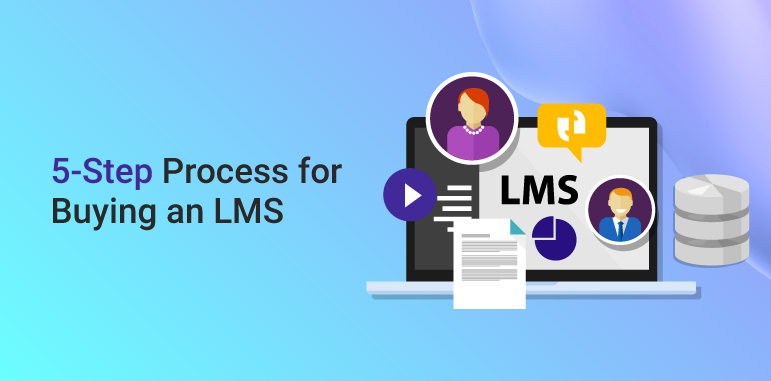Congratulations, you’ve decided to buy an LMS! All that’s left to do now is narrow down from thousands of Learning Management System providers to find the one product that is a right fit for you.
While it sounds a little overwhelming, and it really can be at times, there are 5 things you can do to simplify the LMS buying process.
Step 1: Get sign-off on a budget
Many companies commit this mistake while buying an LMS. It is critical that you start your search for an LMS by narrowing your field to those products that you can afford. If you already own an LMS, you have some idea of what one should cost, so you can go to the check-signer and ask if they are comfortable spending about the same amount of money again next year.
If you have no idea what an LMS should cost (join the crowd!), DO NOT go to the decision maker and ask what they are willing to spend. They also don’t know what it should cost, and it will force them to say something like “I’m willing to spend as much as it takes to get a system we need”. Instead, ask a more specific question that involves a price that they can wrap their mind around. While this might not give you an exact price, but you will have an approximate budget to work around.
Use this line: “Hello Decision Maker, I am in looking for a Learning Management System that will help us better track our employee training so that we can see how our investments in training are paying off. Would you be willing to spend $15,000 a year on this product? I haven’t started searching the market yet, but I’d like to give myself some boundaries to narrow the search.”
Step 2: Create a list of “must-haves”
Please re-read Step 2. It did not say to download an “LMS Buyers Guide” that has 1,000 features pre-loaded into it. The issue with these lists is that it will bias your own ideas about what you need in an LMS, and nobody really knows about what you need except for you. You are better off starting from scratch and building out a unique list of features that only includes items that you know you need to solve your problems. Once you have that list, you should review it one more time and give a ranking (low, medium, high) for each one that shows how critical they are to your success. This list prevents you from being attracted to organizations with exhaustive features that you will never end up using, but you certainly pay for.

Step 3: Collect data
Once you have the excel sheet ready, send out a message to your prospect LMS providers that asks them to provide some basic information. Capterra is a great place to start your search for these providers, but Google always works. In your message to these Learning Management System providers, you need to keep your message short and to the point, including all relevant information. Your goal here is to remove any fluff from your decision-making process so that you can make a data-informed decision.
Here’s a sample: “I’d like to purchase an LMS for my organization of 500 employees. We would like to make a decision on the LMS provider by November 1st. The most important features we need in our LMS are listed below. If your LMS is able to meet those requirements, please respond with a short description along with some ballpark figures (within 20%) of what it would cost to purchase your LMS if we signed a 3-year contract. To make it easier for us to compare costs, please define start-up costs vs. platform costs. Also, we’d like to know if your pricing model is based on total users, or only those users that are active. If it is active, you can assume that 20% of our users would be active.”
Step 4: Measure what is important
After reviewing responses from the previous step, you should select the top five LMS providers from that list based on a combination of their price and ability to fulfil your must-have requirements. During the demo phase, it is important you hold true making a purchase decision based on the features that you care the most about. Do not let the LMS providers waste an hour of your time showing off all of their “cool” features that do not solve the problems you care about. During the demos, you should be actively scoring each product against its ability to meet your requirements. As you will soon find out, reviewing five different products can be confusing and it is very easy to mistake one product’s features with another.
Demo tip: Think about preparing a demo guide and sharing that with all LMS providers that you want to see. This will help you make more of an apple to apple comparison. While you should stick to demoing the features you care about the most, you also might want to provide 10 minutes of free time to the provider to showcase their favorite features.
Step 5: Decide on fit, not on price
First and foremost, you want to find a product that is the best match for your critical requirements. It is not worth considering a lower-cost solution if it doesn’t fulfill your basic needs. Hopefully, these companies were filtered out before this step, but after the product demos you may determine a vendor can’t really do as much as they said they could. If everyone fits the basic requirements, you should look at other variables and decide how important those are to you. While these secondary variables are highly dependent on the organization, most companies we work with place a high value on product vision (how will this LMS product evolve over time) and company culture (would I like to have a long-term partnership with this company).
Negotiation Tip: Regardless of your negotiation style, remember to treat the LMS providers like you would want to be treated. You would be amazed at how much control the individual sales representative has in giving you a great price.
Buying an LMS can sound quite daunting, but if you follow the five steps above, the entire process should not take more than one month. And with most LMS contracts spanning about 3 years, you won’t have to go through the process again anytime soon. To cater to your other L&D requirements, download our free eBook: How to Buy Learning and Development to learn the 6-step procedure on selecting and managing third party L&D suppliers.





